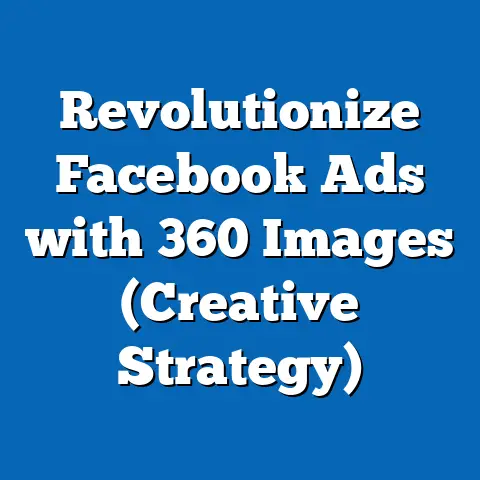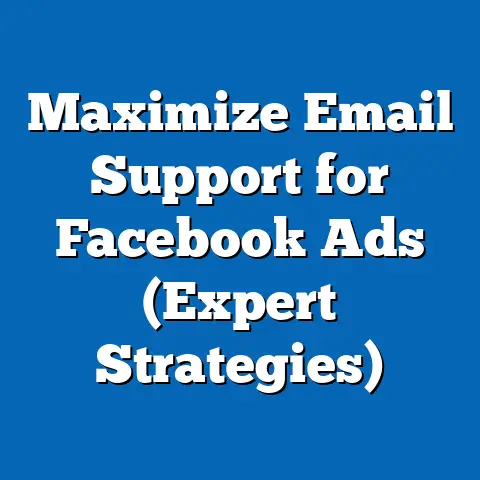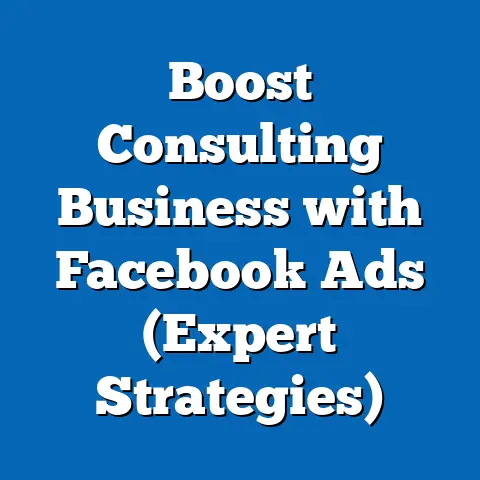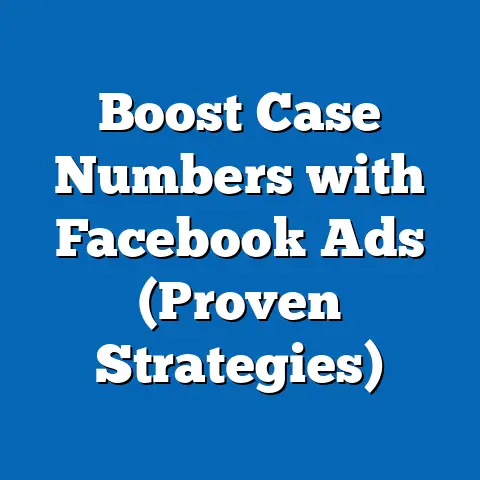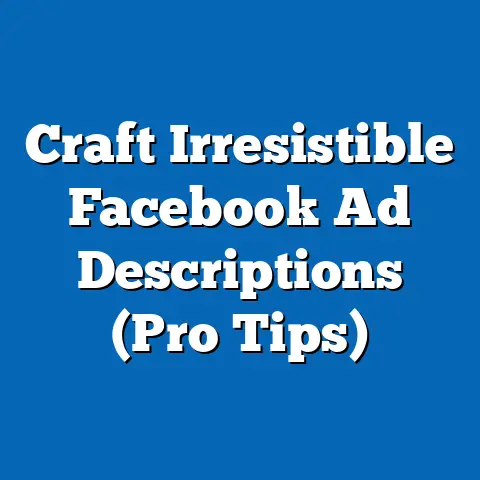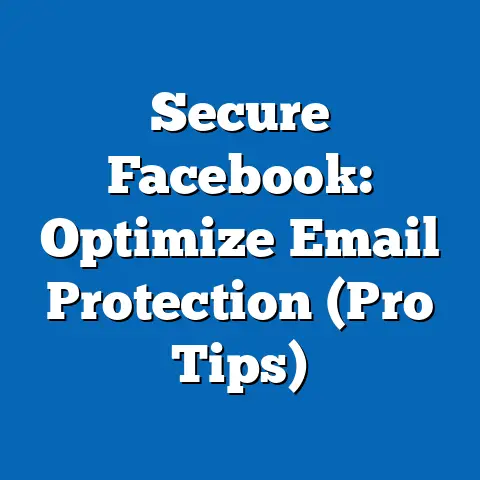Unlock Facebook Insights for Targeted Ads (Strategic Guide)
In today’s world, where environmental consciousness is no longer a niche trend but a mainstream movement, businesses that prioritize sustainability are gaining significant traction. Consumers are increasingly scrutinizing the environmental impact of their purchases, seeking out brands that align with their values. As a business owner, I’ve seen firsthand how adopting eco-friendly practices can enhance brand reputation and drive sales.
Enter Facebook, a powerhouse platform boasting billions of active users and sophisticated advertising capabilities. It’s not just about casting a wide net anymore; it’s about precision, relevance, and connecting with the right audience. For eco-friendly businesses, Facebook offers an unparalleled opportunity to reach environmentally conscious consumers with targeted ads that resonate on a deeper level.
This isn’t just another guide on Facebook advertising. I’m going to delve into the specifics of using Facebook Insights to create ads that truly connect with the eco-conscious consumer. I’ll walk you through setting up your ads, analyzing your target audience, crafting compelling ad copy, and monitoring your results, all while keeping the unique needs of the eco-friendly market in mind. We’ll also explore real-world case studies, dissecting what makes successful eco-friendly ad campaigns tick. Let’s dive in and unlock the potential of Facebook Insights for your eco-friendly business!
Section 1: Understanding Facebook Insights
Facebook Insights is the unsung hero of effective Facebook advertising. It’s a treasure trove of data that provides invaluable information about your audience, your content’s performance, and your overall page activity. For advertisers, it’s like having a direct line to understanding what resonates with your target market.
What is Facebook Insights?
At its core, Facebook Insights is a data analytics tool that provides comprehensive metrics on your Facebook Page’s performance. It allows you to track how users interact with your content, understand their demographics, and identify trends that can inform your marketing strategies.
Why is it Important?
Facebook Insights is crucial for several reasons:
- Audience Understanding: It helps you understand who your audience is, including their age, gender, location, interests, and behaviors.
- Content Optimization: It reveals which types of content perform best, allowing you to tailor your posts for maximum engagement.
- Campaign Effectiveness: It provides data on the performance of your ad campaigns, including reach, impressions, clicks, and conversions.
- Data-Driven Decisions: It enables you to make informed decisions based on data, rather than relying on guesswork.
In my experience, businesses that actively use Facebook Insights consistently outperform those that don’t. It’s like driving with a GPS – you’re much more likely to reach your destination when you have clear directions.
Types of Insights Available
Facebook Insights offers a wealth of data across various categories:
- Overview: A snapshot of your page’s performance, including key metrics like page views, likes, reach, and engagement.
- Followers: Data on your page followers, including their demographics and when they followed your page.
- Likes: Information on the number of likes your page has received, including organic and paid likes.
- Reach: Metrics on the number of people who saw your content, including organic and paid reach.
- Page Views: Data on the number of times your page was viewed, broken down by section and demographics.
- Post Engagement: Information on how people interact with your posts, including likes, comments, shares, and clicks.
- Videos: Metrics on the performance of your videos, including views, average watch time, and audience retention.
- People: Detailed demographics and interests of your audience, including age, gender, location, education, and job titles.
- Messages: Data on the number of messages received by your page, including response time and satisfaction ratings.
Tailoring Strategies for Eco-Friendly Products
For eco-friendly businesses, Facebook Insights is particularly valuable. It allows you to:
- Identify Eco-Conscious Consumers: Target users who have expressed interest in environmental topics, sustainable products, or related causes.
- Understand Their Values: Gain insights into the values and lifestyle choices of your target audience, allowing you to craft messaging that resonates with their beliefs.
- Optimize Content for Engagement: Determine which types of content (e.g., educational articles, product showcases, behind-the-scenes stories) generate the most engagement from your eco-conscious audience.
- Measure Impact: Track the effectiveness of your campaigns in raising awareness, driving sales, and promoting sustainable practices.
Takeaway: Facebook Insights provides the data you need to understand your audience, optimize your content, and measure the impact of your campaigns. By leveraging these insights, you can create more effective and targeted ads that resonate with environmentally conscious consumers.
Next Step: Familiarize yourself with the different sections of Facebook Insights and start exploring the data available for your page.
Section 2: Setting Up Your Facebook Ads
Before you can start leveraging Facebook Insights to create targeted ads, you need to set up your Facebook Ads account and understand the basics of creating a campaign. Let’s walk through the process step-by-step.
Creating a Facebook Ads Account
If you don’t already have one, the first step is to create a Facebook Ads account:
- Go to Facebook Ads Manager: Navigate to https://www.facebook.com/adsmanager and log in with your Facebook account.
- Create an Account: Click on the “Go to Ads Manager” button and follow the prompts to create your account. You’ll need to provide your business information, payment details, and agree to Facebook’s advertising policies.
- Set Up Your Business Manager: For more advanced management of your ads and assets, consider setting up a Facebook Business Manager account. This allows you to manage multiple ad accounts, pages, and users in one place.
Defining Campaign Objectives for Eco-Friendly Initiatives
When setting up your Facebook Ads campaign, it’s crucial to define clear and measurable objectives. For eco-friendly initiatives, some common objectives include:
- Brand Awareness: Increase awareness of your eco-friendly brand and its values.
- Reach: Reach as many environmentally conscious consumers as possible.
- Traffic: Drive traffic to your website or landing page to showcase your products or services.
- Engagement: Encourage likes, comments, shares, and other interactions with your content.
- Lead Generation: Collect leads from potential customers interested in your eco-friendly products or services.
- Conversions: Drive sales or other desired actions, such as signing up for a newsletter or downloading a resource.
Choose the objective that aligns best with your overall marketing goals. For example, if you’re launching a new eco-friendly product, you might choose “Brand Awareness” or “Reach” to generate initial buzz. If you’re looking to drive sales, you might choose “Conversions” and optimize your ads for purchases.
Choosing the Right Ad Formats
Facebook offers a variety of ad formats, each with its own strengths and weaknesses. For eco-friendly messaging, some formats tend to perform better than others:
- Image Ads: Simple and effective for showcasing your products or services with a visually appealing image.
- Video Ads: Highly engaging and ideal for telling your brand story, demonstrating the benefits of your products, or sharing educational content.
- Carousel Ads: Allow you to showcase multiple products or features in a single ad, making them great for highlighting your eco-friendly range.
- Collection Ads: Designed for mobile shopping, these ads feature a hero image or video followed by a selection of related products, making them ideal for driving sales.
- Instant Experience Ads: Full-screen, mobile-optimized ads that provide an immersive experience for users, allowing you to showcase your brand and products in a compelling way.
High-Quality Visuals and Compelling Copy
Regardless of the ad format you choose, it’s essential to use high-quality visuals and compelling copy that align with eco-friendly values.
- Visuals: Use authentic images and videos that showcase your products in a natural and appealing way. Avoid overly staged or artificial imagery.
- Copy: Craft clear and concise ad copy that highlights the benefits of your eco-friendly products or services. Emphasize sustainability, ethical sourcing, and environmental impact.
Takeaway: Setting up your Facebook Ads account and defining your campaign objectives is the first step towards creating targeted ads for eco-friendly products. Choose the right ad formats and use high-quality visuals and compelling copy to capture the attention of your target audience.
Next Step: Create your Facebook Ads account (if you haven’t already) and start experimenting with different ad formats to see what works best for your brand.
Section 3: Analyzing Your Target Audience
Understanding your target audience is the cornerstone of effective Facebook advertising. Facebook Insights provides a wealth of data that can help you analyze and define your ideal customer, allowing you to create ads that resonate with their interests, values, and behaviors.
Demographic Metrics
Demographic metrics provide insights into the basic characteristics of your audience, such as:
- Age: Identify the age ranges that are most interested in your products or services.
- Gender: Determine the gender breakdown of your audience.
- Location: Understand where your audience is located, both geographically and in terms of urban vs. rural areas.
- Education: Gain insights into the education levels of your audience.
- Job Titles: Identify the types of jobs your audience holds.
For eco-friendly businesses, it’s crucial to identify consumers who are not only interested in environmental topics but also have the purchasing power to support sustainable products.
Psychographic Metrics
Psychographic metrics delve deeper into the values, attitudes, and lifestyle choices of your audience. This information is essential for crafting messaging that resonates with their beliefs and motivations. Some key psychographic factors to consider include:
- Values: What values are important to your audience? Do they prioritize sustainability, ethical sourcing, or environmental conservation?
- Attitudes: What are their attitudes towards environmental issues? Are they passionate about climate change, pollution, or animal welfare?
- Lifestyle Choices: What lifestyle choices do they make that align with sustainability? Do they recycle, compost, buy organic food, or drive electric vehicles?
- Interests: What are their interests outside of environmental topics? Do they enjoy outdoor activities, healthy living, or conscious consumerism?
Identifying Eco-Conscious Consumers
Using Facebook Insights, you can identify eco-conscious consumers by:
- Analyzing Page Likes: Look for users who have liked pages related to environmental organizations, sustainable brands, or eco-friendly products.
- Identifying Interests: Target users who have expressed interest in topics such as “sustainability,” “environmentalism,” “organic food,” or “renewable energy.”
- Observing Behaviors: Identify users who have engaged with content related to environmental issues, such as sharing articles, commenting on posts, or attending events.
- Using Custom Audiences: Create custom audiences based on your existing customer data and target users who have similar characteristics to your most eco-conscious customers.
Examples of Successful Audience Targeting
Here are a few examples of how different eco-friendly brands have successfully identified and targeted their audiences using Facebook Insights:
- Sustainable Fashion Brand: Identified users who liked pages related to ethical fashion, fair trade, and veganism. They also targeted users who had expressed interest in sustainable living and conscious consumerism.
- Green Home Products Company: Targeted users who liked pages related to organic cleaning products, energy-efficient appliances, and eco-friendly home decor. They also targeted users who had expressed interest in DIY projects and home improvement.
- Organic Food Brand: Identified users who liked pages related to organic farming, healthy eating, and vegetarian or vegan diets. They also targeted users who had expressed interest in local food and farmers’ markets.
Takeaway: Analyzing your target audience using Facebook Insights is essential for creating ads that resonate with their interests, values, and behaviors. By focusing on demographic and psychographic metrics, you can identify eco-conscious consumers and tailor your messaging to their specific needs and motivations.
Next Step: Use Facebook Insights to analyze your existing audience and identify potential new customers who are interested in eco-friendly products and services.
Section 4: Crafting Targeted Ads for Eco-Friendly Products
Now that you understand your target audience, it’s time to craft compelling ad copy that resonates with eco-friendly consumers. Here are some strategies to help you create ads that capture their attention and drive engagement:
Emphasizing Sustainability, Ethical Sourcing, and Environmental Impact
Eco-conscious consumers are deeply concerned about the environmental and social impact of their purchases. Therefore, it’s crucial to highlight the sustainability, ethical sourcing, and environmental benefits of your products or services in your ad copy.
- Sustainability: Emphasize the use of sustainable materials, eco-friendly manufacturing processes, and responsible packaging.
- Ethical Sourcing: Highlight the ethical treatment of workers and suppliers involved in your supply chain.
- Environmental Impact: Quantify the environmental benefits of your products or services, such as reducing carbon emissions, conserving water, or protecting biodiversity.
Storytelling in Advertising
Storytelling is a powerful tool for connecting with consumers on an emotional level. Eco-friendly brands can use storytelling to share their mission, values, and the impact they’re making on the world.
- Share Your Brand Story: Tell the story of how your company was founded, why you’re committed to sustainability, and what you’re doing to make a difference.
- Highlight Your Values: Emphasize the values that guide your business, such as transparency, integrity, and environmental stewardship.
- Showcase Your Impact: Share stories of the positive impact your products or services are having on the environment or the communities you serve.
Calls-to-Action (CTAs) for Engagement and Conversions
Your ad copy should include clear and compelling calls-to-action (CTAs) that encourage engagement and conversions. Tailor your CTAs to the specific goals of your campaign and the interests of your target audience.
- Learn More: Encourage users to visit your website or landing page to learn more about your products or services.
- Shop Now: Drive sales by inviting users to purchase your products directly from your ad.
- Sign Up: Collect leads by inviting users to sign up for your newsletter, download a resource, or register for an event.
- Join Us: Encourage users to join your social media community and engage with your content.
Examples of Successful Eco-Friendly Ad Campaigns
Here are a few examples of successful eco-friendly ad campaigns on Facebook:
- Patagonia: Patagonia’s ads often feature stunning visuals of outdoor landscapes and compelling stories of environmental activism. Their CTAs encourage users to learn more about their sustainability initiatives and support their conservation efforts.
- Allbirds: Allbirds’ ads highlight the sustainable materials used in their shoes and the company’s commitment to reducing its environmental impact. Their CTAs invite users to shop their collection and learn more about their sustainable practices.
- Beyond Meat: Beyond Meat’s ads showcase the plant-based ingredients in their products and the environmental benefits of reducing meat consumption. Their CTAs encourage users to try their products and learn more about the plant-based movement.
Takeaway: Crafting targeted ads for eco-friendly products requires a deep understanding of your audience’s values and motivations. By emphasizing sustainability, ethical sourcing, and environmental impact, you can create compelling ad copy that resonates with eco-conscious consumers.
Next Step: Start experimenting with different ad copy variations and CTAs to see what generates the most engagement and conversions from your target audience.
Section 5: Monitoring and Adjusting Your Ads
Creating a great ad is only half the battle. The other half is diligently monitoring its performance and making necessary adjustments to optimize your ad spend and improve results. Facebook Insights provides the tools you need to track your ad performance and make data-driven decisions.
Monitoring Ad Performance Using Facebook Insights
Facebook Insights offers a range of metrics that can help you track the performance of your ads:
- Reach: The number of unique users who saw your ad.
- Impressions: The number of times your ad was displayed.
- Click-Through Rate (CTR): The percentage of users who clicked on your ad after seeing it.
- Conversion Rate: The percentage of users who completed a desired action (e.g., purchase, sign-up) after clicking on your ad.
- Cost Per Click (CPC): The average cost you paid for each click on your ad.
- Cost Per Conversion (CPC): The average cost you paid for each conversion generated by your ad.
- Engagement: The number of likes, comments, shares, and other interactions your ad received.
A/B Testing Ad Variations
A/B testing involves creating multiple versions of your ad with slight variations (e.g., different headlines, images, CTAs) and testing them against each other to see which performs best. This is a valuable way to optimize your ad copy and visuals for maximum impact.
- Test Different Headlines: Experiment with different headlines to see which ones capture the most attention.
- Test Different Images: Try different images to see which ones resonate best with your target audience.
- Test Different CTAs: Vary your CTAs to see which ones drive the most engagement and conversions.
- Test Different Targeting Options: Experiment with different targeting parameters to see which ones reach the most relevant audience.
Adjusting Targeting Parameters
Based on the insights you gain from ad performance, you may need to adjust your targeting parameters to optimize your ad spend and improve results.
- Refine Your Audience: Narrow down your target audience based on demographics, interests, and behaviors.
- Exclude Irrelevant Users: Exclude users who are not interested in your products or services.
- Expand Your Reach: Expand your target audience to reach new potential customers.
Common Pitfalls to Avoid
Here are some common pitfalls to avoid when monitoring and adjusting your ads:
- Making Decisions Too Quickly: Don’t make changes to your ads based on limited data. Allow your ads to run for a sufficient period of time to gather statistically significant results.
- Changing Too Many Variables at Once: When A/B testing, only change one variable at a time so you can accurately determine which change is responsible for the results.
- Ignoring Negative Feedback: Pay attention to negative feedback (e.g., negative comments, low engagement) and use it to identify areas for improvement.
- Setting It and Forgetting It: Don’t assume that your ads will continue to perform well indefinitely. Continuously monitor your ad performance and make adjustments as needed to stay ahead of the competition.
Takeaway: Monitoring and adjusting your ads is essential for optimizing your ad spend and improving results. By tracking key metrics, A/B testing ad variations, and refining your targeting parameters, you can ensure that your ads are reaching the right audience with the right message.
Next Step: Implement a system for regularly monitoring your ad performance and making data-driven adjustments to optimize your campaigns.
Section 6: Case Studies of Successful Eco-Friendly Brands on Facebook
To illustrate the power of Facebook Insights and targeted advertising for eco-friendly businesses, let’s explore some real-world case studies of brands that have achieved success on the platform.
Case Study 1: Package Free Shop
Brand Overview: Package Free Shop is a zero-waste online retailer that offers a wide range of sustainable alternatives to everyday products.
Strategy: Package Free Shop uses Facebook ads to drive traffic to its website and promote its zero-waste mission. Their ads often feature visually appealing images and videos of their products, along with compelling copy that highlights the environmental benefits of reducing waste.
Insights:
- Audience: Package Free Shop targets environmentally conscious consumers who are interested in sustainable living, zero-waste products, and ethical sourcing.
- Messaging: Their ads emphasize the convenience and affordability of zero-waste products, as well as the positive impact they have on the planet.
- Engagement: Package Free Shop actively engages with its audience on Facebook, responding to comments and questions and sharing educational content about zero-waste living.
Outcomes:
- Increased brand awareness and website traffic.
- Strong customer loyalty and repeat purchases.
- Positive brand reputation and recognition as a leader in the zero-waste movement.
Case Study 2: Tentree
Brand Overview: Tentree is an apparel company that plants ten trees for every item purchased.
Strategy: Tentree uses Facebook ads to promote its apparel and its tree-planting mission. Their ads often feature stunning visuals of natural landscapes and compelling stories of the impact they’re making on the environment.
Insights:
- Audience: Tentree targets environmentally conscious consumers who are interested in sustainable fashion, outdoor adventures, and social impact.
- Messaging: Their ads emphasize the quality and style of their apparel, as well as the positive impact of their tree-planting initiative.
- Transparency: Tentree is transparent about its tree-planting process, providing customers with updates on the progress of its projects.
Outcomes:
- Increased brand awareness and website traffic.
- Strong customer loyalty and repeat purchases.
- Positive brand reputation and recognition as a leader in sustainable fashion.
Case Study 3: Grove Collaborative
Brand Overview: Grove Collaborative is an online retailer that offers a curated selection of eco-friendly home and personal care products.
Strategy: Grove Collaborative uses Facebook ads to promote its products and its mission to make sustainable living accessible to everyone. Their ads often feature visually appealing images and videos of their products, along with compelling copy that highlights the environmental benefits of using sustainable alternatives.
Insights:
- Audience: Grove Collaborative targets busy families who are interested in making sustainable choices but don’t have a lot of time to research and shop for eco-friendly products.
- Convenience: Their ads emphasize the convenience and affordability of their subscription service, which delivers sustainable products directly to customers’ doors.
- Community: Grove Collaborative fosters a strong sense of community among its customers, providing them with educational resources, exclusive discounts, and opportunities to connect with other like-minded individuals.
Outcomes:
- Increased brand awareness and website traffic.
- Strong customer loyalty and repeat purchases.
- Positive brand reputation and recognition as a leader in the sustainable home and personal care market.
Takeaway: These case studies demonstrate the power of Facebook Insights and targeted advertising for eco-friendly businesses. By understanding their audience, crafting compelling messaging, and actively engaging with their community, these brands have achieved significant success on the platform.
Next Step: Analyze these case studies and identify strategies that you can apply to your own Facebook advertising efforts.
Conclusion
In conclusion, Facebook Insights is an invaluable tool for eco-friendly businesses looking to create more effective and targeted advertising campaigns. By leveraging the data provided by Facebook Insights, you can gain a deep understanding of your audience, craft compelling messaging that resonates with their values, and optimize your ad spend for maximum impact.
Remember, the key to success on Facebook is to be authentic, transparent, and committed to your mission. Eco-conscious consumers are savvy and discerning, and they’re more likely to support brands that align with their values and demonstrate a genuine commitment to sustainability.
By combining the power of Facebook Insights with a strong brand message and a commitment to sustainability, you can unlock the full potential of your Facebook advertising efforts and contribute to a more sustainable future.
Call to Action: Start applying the strategies discussed in this article to unlock the full potential of your Facebook advertising efforts for eco-friendly products. Let’s work together to create a more sustainable future, one ad campaign at a time.

